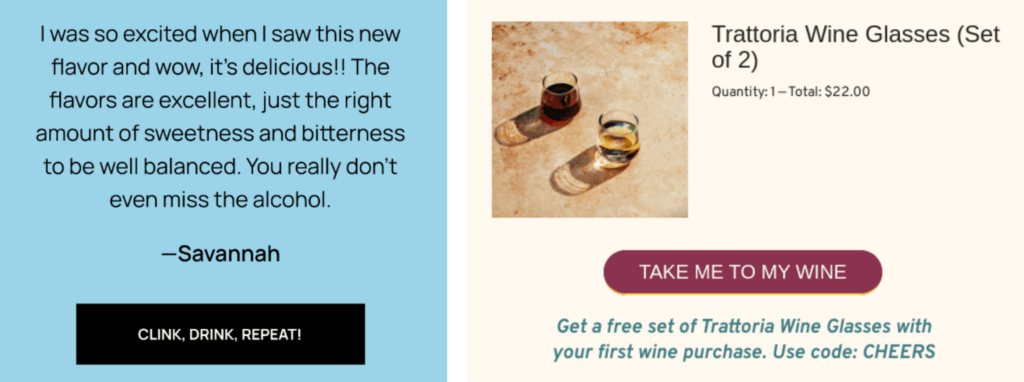- Home
- Fundamentals of Email Marketing
- Call-to-Action in Email: A/B T ...

Picture this: You wrote a perfect email only to find no response. But you were hoping your performance metrics—open rate and click-through rate (CTR)—would rise as soon as you hit the “send” button.
Here enter the mighty call-to-action (CTA) buttons. They take your readers towards the good stuff—subscribe, buy, download, sign up, or anything you want. A strong CTA helps you avoid flat performance.
We’ll show you some data to back our argument here. A study by HubSpot revealed emails with a well-defined CTA had a 2.13% higher CTR compared to ones that did not. This means more people clicked the button and took action. Let us tell you another fact. Emails with a single (and well-designed) call to action had clicks increase by 371% and sales by 1617% (Wordstream).
But even the best CTA design can miss the mark if it isn’t according to your audience preferences. That’s where A/B testing, or split testing, comes in. It is simply comparing two emails with different CTAs and choosing the one with the best results. Then you send both versions to see which one is doing better and what makes your audience tick.
Why should you do A/B testing to optimize CTA buttons in your marketing emails? Read on to find out.
A/B Testing Basics: CTA Buttons
Have you ever felt like some CTAs really seem to be begging you to click? It’s A/B testing.
A/B testing your CTA in email marketing gives you data-backed insights. As we discussed earlier, you are going to make two versions of your email, each with a slightly different “click here” button.
What does it mean? If you think your CTA button can work effectively if you place it differently, you need to create multiple versions of the button and run an A/B test to check.
Before we discuss email CTA best practices, let’s start with the fundamentals.
Here’s what you track to see which one works best:
- Open rates: Did your email catch their eye? This shows how many people actually opened it.
- Click-through rates: Did they click the button? This is your golden metric for CTA success!
- Conversion rates: Did they take action after clicking? This shows if they actually signed up, bought something, or did whatever you wanted them to do.
- Engagement rates: Were they interested overall? This tracks things like opening other links or scrolling through the email.
Use these metrics to compare two email versions to find out the best CTAs for email—the most persuasive click magnet!
Ready to put your CTAs to the test?
A/B Testing Tips for Email CTA Buttons
Your CTA can be the portal to your email success. It’s far beyond “Shop now” and “Get started” buttons. There are a lot of A/B test different elements that might get the most clicks.

1. Text and copy
Your CTA button’s text also plays an important role. What it says makes the difference as it influences the recipient’s decision to click. Here are a few things to test for text and copy:
- Action-oriented words: The text on the button is always an infinitive verb in the infinitive. This verb must match the verb in the call to action. For example, if the call is “Leave a request and get a free consultation,” then the CTA text is “Get a Free Consultation.”
Test strong verbs like “Buy Now” or “Get Started” that create a sense of urgency against softer ones like “Shop Now.” Check which drives more clicks.
- Text length: Compare short and sweet CTAs (like “Get Started”) with longer, descriptive ones (like “Start Your Free Trial Now”). Snappy or informative? You will see!
- Personalization: Test personalized CTAs (“Start Your Free Trial, [Name]!”) against generic ones. A personal touch can make the recipient feel special and more likely to click.
Examples:
- “Get 20% Off” vs. “Grab Your 20% Discount Now!”
- “Sign Up” vs. “Sign Up for Our Exclusive Newsletter!”
Testing variations in copy helps identify which approach resonates more with your audience.
2. Color and contrast
These two factors influence visibility and attractiveness and make your CTA button stand out and grab attention. Here’s what you can experiment with:
- Button colors: The button must be of a unique color. It should fit into the overall color scheme.
Experiment with different colors to identify the most eye-catching option. Colors like red and green are popular choices as they grab more attention.
- Contrast: Compare buttons that have a lot of contrast (think a bright red button on a white background) with buttons that don’t (like a gray button on a light gray background). Do readers see the call to action?
It’s important to note that other email elements should not resemble your CTA, as this confuses the reader.
Examples:
- High-contrast: Bright yellow button on a black background.
- Low-contrast: Light blue button on a white background.
This can help you identify which colors are attractive and lead to higher click-through rates.
3. Size and shape
The size and shape of your CTA button play a role in how many clicks it gets. Here’s what to consider:
- Button size: Test larger buttons against smaller ones. Do they get noticed more easily?
- Button shape: Compare classic rectangles with buttons featuring rounded corners. Which feels more clickable?
Examples:
- Large: 200px wide button.
- Small: 100px wide button.
- Shape: Rectangular vs. rounded corners.
This can help determine the optimal size and shape that encourages clicks.
4. Placement and positioning
Your CTA button won’t get many clicks if no one knows where to look! Here are some ideas for testing CTA placement:
- Above the fold or below: Experiment with putting your CTA button at the very top of your email (where people see it right away) vs. placing it further down (where they might need to read a bit more first).
- Multiple CTAs: Compare having just one CTA button with having several buttons scattered throughout your email.
Buttons can compete with each other, confusing readers. Never place two buttons in one block at once.
Examples:
- A CTA button placed immediately after the introductory paragraph.
- One button placed at the end of the email.
Testing different CTA placements lets you compare the effectiveness of these two factors.
5. Design and visual elements
A CTA button that’s visually appealing is more inviting and likely to get clicked. Here are some design elements to play around with:
- Icons and graphics: Test buttons with icons (shopping cart) against text-only ones. Do visuals enhance clarity?
- Hover effects: Compare static buttons with the ones with hover effects (e.g., change color on hover). Does interactivity make a difference?
Examples:
- Icon: Button with a download icon.
- Hover effect: Button that changes color when hovered over.
See yourself if additional design elements improve click-through rates.
More tips on email design A/B testing: Optimizing Email Design Through A/B Testing: Best Practices and Examples
6. Urgency and social proof
Buttons with a specific offer always turn out to be more converting. People just need a little extra push to take action on your email. Here are two ways to prompt immediate action:
- Urgency: Try adding a sense of urgency to your CTA button, like “Limited Time Offer.” This can make people feel like they need to act fast before they miss out.
- Social proof: People would do something if they see others doing it too. Test CTAs that mention social proof, like “Join 10,000+ Subscribers.” Do people click more if they see others doing it?
Examples:
- Get 50% Off—Limited Time Offer!
- Hurry! Only 5 Spots Left—Book Now!
- Claim Your Free Ebook—Offer Ends Today!
Test these elements to see if they enhance the persuasiveness of your CTA.
We hope these call-to-action email examples will help you in crafting the best one for yourself. And it has cleared out many confusing things, such as how to decide a CTA design, and answered the question, “How long should a call-to-action be?”
Making Sense of A/B Test Results
Once you are done with your A/B tests, let’s take the detective approach to analyze results and see what worked best.
- Collect data: Collect all the info on every CTA variation you tested from your email marketing platform.
- Analyze performance: Check performance based on opens, clicks, conversions, and engagement. These metrics paint the exact picture of how many people opened the email, clicked the button, took the desired action, etc.
- Determine the best performer: You can use this data to figure out which CTA variation came out on top and why. Was it the color, the wording, the size, or the placement? Was it the rectangular button that got more clicks? Did the shorter message outperform the longer one?
- Refine and continue testing: Continue perfecting your recipe. Tweak your CTAs (text, color, etc.) based on what worked best to create the most clickable ones.
Best Practices for A/B Testing CTA Buttons for Emails
To get the most out of your A/B tests, follow these best practices:
- Isolate variables: Test one element at a time (color, text, etc.) to ensure clear and actionable results.
- Synchronized sending: Send variations simultaneously to avoid outside influences that could skew results.
- Segmented audiences: Divide your audience for fair and balanced comparisons.
- Sample size matters: Get enough people involved for reliable data.
- Continuous improvements: Keep testing and refining your CTAs based on learnings.
Common Mistakes to Watch Out For
Avoid these common mistakes to ensure your A/B tests are effective:
- You can only get a proper idea of conversion rate if you test it with one or two elements.
- One optimized CTA can increase conversion rates, but you shouldn’t expect too much in a short time.
- Hasty tests can yield inaccurate data.
- The testing timeline should be based on your goal; It shouldn’t be too long or too short.
- If you change your objective or any other aspect in the middle of the testing, it will result in incorrect data.
- You should constantly test different elements and consider negative results to help you make future improvements.
To Sum Up
We hope we have cleared up the basic question you had in mind: Why do I need to A/B test my CTA buttons? After all, it’s not just enough to draft a winning email that won’t even help your business increase its return on investment (ROI).
Let’s revise the crucial points! A CTA is the most important thing that directly affects conversion rates. And A/B testing gives you insights—understand which CTAs are most effective in getting your readers to take action.
You can experiment with different colors, wording, sizes, and placements to see what makes people click the most. By following these email CTA best practices, you will be able to design the best CTAs for email and turn those clicks into more engagement and sales for your business.
So, what are you waiting for? Start A/B testing your CTAs and get the most out of your marketing email campaigns!



